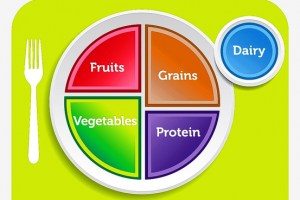I was doing research for my latest Federal Hill Gazette article (Chick it out in our ‘Articles’ section) and I found this article by Cassandra Forsythe-Pribanic, PhD, RD. The title alone intrigued me. Cassandra’s approach is friendly yet blunt. She is not afraid to criticize the Government’s latest attempts at fixing our diets. Here is her article:
Just a few days ago (June 2, 2011), the USDA unveiled its new way of helping Americans eat better because, as we all know, this country has a major obesity problem; well over half of our citizens are overweight and obese, and the outlook is not getting any thinner.
Instead of telling people to eat a “rainbow” of foods, we’re now given an ideal “plate” that is supposed to magically help people eat less junk food and more good food.
This plate tells us to eat fruits, vegetables, grains, some sort of protein, and dairy at every meal. But, is this the way Americans should eat all the time?
Let’s look at the breakdown and the new supposedly “easy-to-understand” recommendations and see if they really make sense.
First the daily plate breakdown: Should we really always eat grains, dairy, fruits, vegetables, and protein at every meal?
Well, it depends on who you ask.
Some people feel that grains are detrimental to our health and digestive system and shouldn’t be eaten at all, while other people are very intolerant to cow’s dairy and can’t consume any. So, if you ask these people, this plate wouldn’t work for them.
But, what if you can eat grains and dairy?
If you eat grains, why does the government insist that only half of the grains we are supposed to eat be whole?
Why don’t they just state that ALL grains should be whole, like brown rice, barley, and bulgur, instead of whole-wheat bread, pasta, or crackers, which are still just simple carbohydrates?
If the whole point of this new plate is to improve our health and slim our waistlines, why beat around the bush? Tell people what they really need to hear.
Then there’s dairy: We’re told to switch all our dairy to fat-free or low-fat (1%). However, where have these government experts been living for the past decade?
Obviously under a rock, because if they were actually reading the recent science, they’d learn that many dairy and lipid experts have found there is little to no reason to limit dairy fat, and that the saturated fat in dairy may actually be protective against developing diseases, like diabetes.
Instead, the recommendation should be to drink natural, unsweetened dairy, instead of the sugar-chocolate or strawberry dairy that kids in school today are fed at lunch.
How about the fruits and vegetables?
It can be argued that we should eat twice as many vegetables (especially green, non-starchy vegetables) compared to fruits each day because they are lower in sugars and total calories, which many of us get too many of now as it is.
So, to say that each meal should contain both, may not be the most wise of recommendations. Rather, a bigger portion of vegetables versus fruits would be more reasonable to eat with every meal.
And then there’s protein: It doesn’t specifically state where this protein should come from, which means it could come from processed meats like low-fat hot dogs, rather than unprocessed protein, like eggs (which contain fat, gasp!).
It is good that a person can choose vegetarian or animal proteins at their own will if that’s what works best for their body, but it still doesn’t insist on unprocessed versus synthetic, which it should.
However, it’s at least a step-up that they finally recognize that higher protein diets are not detrimental for our health, but instead are more helpful for healthy body weight regulation.
Overall, this plate idea is a nice thought, but it still has its major flaws.
It doesn’t encourage people to choose unprocessed foods over whole items, because it still suggests that we eat frozen meals (that we probably microwave in a plastic container); and doesn’t address our overconsumption of sugar in snacks, desserts, and hidden in common foods like breads and salad dressings.
It also still gives the message that we should eat a low-fat diet, which unless that fat is hydrogenated or associated with sugar, is not really necessary because as we cut out fat, we increase carbs, which have been shown to do nothing for our current society except make us more overweight and addicted to sugar.
Overall, an ideal food plate would recommend something like this:
• Eat home-cooked food as often as you can and enjoy minimally processed, natural foods
• Avoid artificial colors, sweeteners, flavors, and preservatives all the time
• Drink water, or unsweetened tea or coffee with each meal
• Choose dairy, if you can tolerate it, and ensure it is not loaded with sugar (like yogurt)
• Select natural, unprocessed proteins from animal or vegetable sources
• Make half your plate fresh or cooked vegetables, and a quarter can be fresh fruit
• If you choose grains, ensure they are always whole and never processed
• Add natural fats like olive oil, nuts, or meat and fish oils to your plate to help you feel full and maintain ideal health
This is simple, blunt, and to the point, and doesn’t leave a person wondering if that microwave dinner with vegetables is better than a fresh salad with baked turkey breast and olive oil dressing. Let’s stop trying to pull the sheets over our eyes and pretending like most of our diets don’t need a major overhaul, because they do.
By Cassandra Forsythe-Pribanic, PhD, RD
So . . . what do you think?
Stay Strong and Healthy,
Peter Holmes




Speak Your Mind